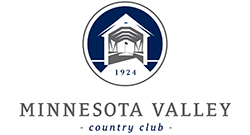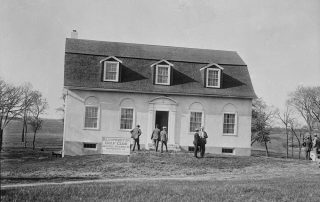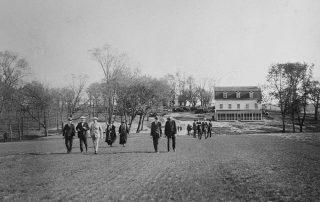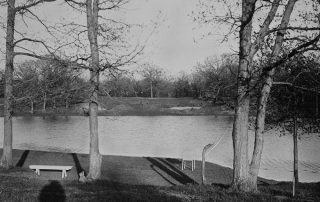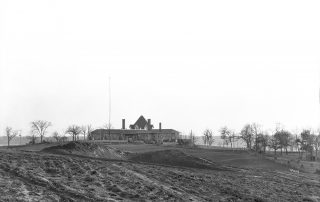
Minnesota Valley Country Club
Established 1924
Our history began just across the road on a scenic bluff of the great Minnesota River Valley.
In 1911, after searching for the perfect spot, The Automobile Club of Minneapolis built the AAA Auto Club at Bloomington-on-the-Minnesota. This spectacular “country club” offered members a scenic getaway where they could dine, dance, and together, enjoy the sights and sounds of the river that gave the state of Minnesota its name.
In the years that followed what came to be called the Bloomington Auto Club, was the preferred destination for a drive in the country and scenic socializing. By the end of the decade it had become a gathering spot for the prominent, influential, and wealthy, many who were part of the growing Twin Cities golf community.
 Toward the end of the decade, Auto Club members began eyeing farm land across the road from their country clubhouse to build a golf course. They felt it was an ideal location, far from the hustle and bustle of city life in an area where none existed. Descendants of the land owners relay how inquiries began well before 1922, when 160 acres of fertile ground to the north was acquired by the Auto Club for a golf course. On August 1st 1923 a newspaper reported;
Toward the end of the decade, Auto Club members began eyeing farm land across the road from their country clubhouse to build a golf course. They felt it was an ideal location, far from the hustle and bustle of city life in an area where none existed. Descendants of the land owners relay how inquiries began well before 1922, when 160 acres of fertile ground to the north was acquired by the Auto Club for a golf course. On August 1st 1923 a newspaper reported;
Bloomington Golf Club Directors are Elected
First steps toward permanent organization of the Bloomington Golf Club, a subsidiary of the Automobile Club of Minneapolis, were taken with election of directors Tuesday night. The directors are:
Earle M. Barrows, chairman; George K. Belden, Frank C. Berry, Lewis F. Bolser, George T. Freeman, Frank S. Gold, H.C. Mackall, William S. McCarthey, George F. Orde, Gaylord Warner, Leon C. Warner and G.A. Will.
Tract Pronounced Ideal.
“Dr. C.V. Piper of the U.S. department of Agriculture, a recognized expert on grasses, visited the (BAC) golf tract recently in company with Earle M Barrows, a club director, and a member of the Twin Cities greens section, pronounced the soil generally excellent for the support of fine putting greens and fairways”
The board soon communicated their intent to build one of the finest links courses in the Midwest and revealed their unique membership plan. Described as an experiment by a reporter, who wrote the Bloomington Golf Club:
“probably is the only club of its kind in the country. The membership, of course, will be limited to 300 persons. But every member of the Automobile club and his guests will have playing privileges for a nominal fee. It also is the plan that tourists who are members of the American Automobile Association be given the same privileges.
They also announced;
“ A nationally famed architect had been retained to lay out the links which will be directly across the River road near the Automobile club.”
Seth Raynor gained his national fame as the promoted protege of Charles Blair Macdonald, who built the first 18 hole golf course in America in 1892. In 1911 the Macdonald designed and Raynor built National Golf Links of America opened in Southampton on Long Island. Macdonald, who lived in Scotland for years and attended university in St Andrews, had long envisioned building an “Ideal” links course in America, utilizing the best strategies and features of Scotland’s best holes.
In the years that followed the rave reviews for the National, a bold, strategic, challenging links course, spread throughout the golf community in America. By 1914 requests for new golf courses were pouring in, Macdonald a wealthy man of wall street, was not interested, and referred the requests to his protege Raynor. An office was established in NYC, and Raynor began accepting design projects from around the country.
As is typical with Raynor, details are absent on when and how often he visited the “ideal” property across the street from the Bloomington Auto Club. Although an engineer, Raynor was well known for his inability to keep records or documentation of his work. He lived almost full time on the road, relentlessly traveling by train, to the myriad of projects at various stages of development he was involved with.
One visit was all Raynor needed, as he demonstrated the uncanny ability to visit a site one time, and by the next day have a clear picture in his mind of the course. This remarkable skill was revealed in 1918 in the only interview of Raynor on record. Raynor purportedly designed a course in New Orleans from his office in NYC, with just a topographical map of the property. As was his standard practice, he sculpted models for all 18 greens, which the superintendent of construction traveled to NYC to obtain’
Construction commenced at the Bloomington Golf Club and Scotsman Bill Clark was the onsite superintendent, a role he also fulfilled in 1916 at Minneapolis Golf Club. Ivar Daly, his son John Daly, and other local crews constructed the course. The site contouring was done very primitively by horse and scraper. Planting of the greens was contracted out to Barrow’s Grass Nursery, located on the Minnesota River, and completed using plugs of bent grass. A system of water pipes was installed on the course and by the fall of 1924 all that was needed was good weather for an opening the following year.
With some minor enhancements, including a verandah, the large farm barn became the first golf course locker room. A dirt road called Old Bluff Road was all that separated the Auto Club from the golf course. They erected a sign along the road that stated Bloomington Golf Club and “ privileges extended to members of the American Automobile Association”.
Members were invited to a course warming party in mid-April 1925 for an inspection of the locker room and golf course. In early May, 1925, the Bloomington Golf Club opened for play. First year members were entitled to ten free rounds annually, with any additional rounds costing fifty cents a game. The golf course was reserved for members only on weekends, but allowed the public to play on weekdays. Auto Club members now enjoyed the game of golf on their new course, with fine dining and Jazz Age dancing just across the street in their “country club”.
In 1938, seven major stockholders led by Dr. William Naegele and Dr. Arthur Swanson, purchased the golf course and buildings for $38,000. The club was renamed Minnesota Valley Country Club, a completely private club with an emphasis on golf, and Naegele became its first President, a role he fulfilled until his death in 1966.
Over the next sixty years the Club experienced many highs and lows associated with economies and world wars. In 1952, a major three-story addition was made to the original barn locker room. Across the road, the original Auto Club would eventually fall on hard times and was demolished in the mid-50’s. In 1997, after carefully reviewing all options, the Club demolished the original clubhouse and built a new clubhouse further from the road with sweeping views of the golf course.
Serendipitously the Club retained Raynor’s original layout over the years and the course was largely unaltered for 90+ years. In 2022 Minnesota Valley completed a course renovation upgrading infrastructure, renovating all bunkers, adding 40+ tee boxes, and magnifying Raynor’s fun features, interesting greens, and iconic hole designs.
In early 2024 a renovation of our Clubhouse will be complete. Our 19th hole has a spectacular new Pub on the lower level, with a spacious patio providing an amazing view. While upstairs is a completely renovated Seth Raynor Grill, also providing scenic views, and a superb new Pro Shop overlooking our 9th & 10th holes.
Minnesota Valley Country Club is a historic club, boasting a long tradition of enjoyment for its members, and widely acclaimed for its welcoming culture. Our members feel fortunate to play and share with family-friends, our Seth Raynor designed Minnesota Masterpiece.
In July of 2024 we will share our magnificent course with the best amateur golfers from around the state, as we host the 121st MGA Amateur Championship.
